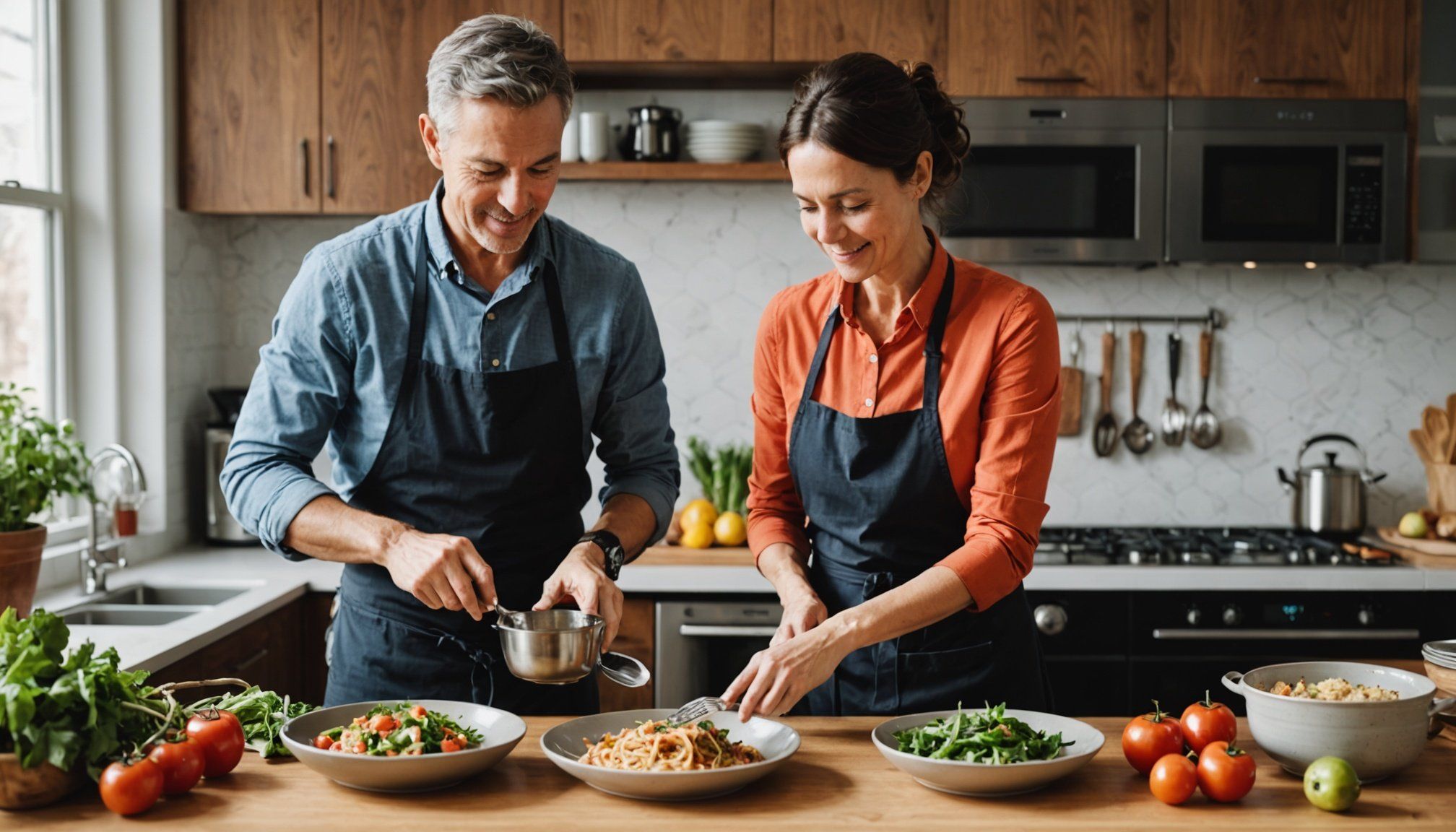Fundamental Cooking Techniques
Understanding basic culinary skills forms the cornerstone of any cooking journey. These essential methods not only prepare you to cook confidently but also equip you with the flexibility to experiment.
Knowing how to sauté allows you to quickly cook vegetables or proteins, enhancing flavours with minimal effort. Begin by heating a small amount of oil in a pan before adding ingredients, stirring continuously over high heat until cooked through. Boiling is another fundamental technique which focuses on cooking items thoroughly in water, often used for vegetables, pasta, or rice. Ensure your water reaches a bubbling state before adding food, and use salt to elevate taste.
Also to see : Master Chef Secrets: Transform Your Meal Success with These Innovative Cooking Techniques
Baking, on the other hand, employs dry heat and is ideal for bread, cakes, or casseroles. Ensuring your oven is preheated to the desired temperature is crucial for success. Finally, grilling gives food a distinct, charred flavour, perfect for meats and vegetables. Control the temperature through gas or charcoal for even cooking.
Regular practice at home is key. Start with simple recipes to gradually improve these cooking techniques. Over time, with patience, you’ll find yourself refining these essential skills, leading to mastery.
Topic to read : Master Professional Cooking Skills in the UK for 2024: A Step-by-Step Guide
Adaptability in Cooking
In the ever-evolving world of cooking, adaptability is an invaluable asset. This flexibility ensures that even if an ingredient is missing, the dish can still shine. Flexible cooking often involves clever ingredient substitution, which not only encourages creativity but also reduces waste.
For example, if a recipe calls for eggs, mashed bananas or applesauce could work as substitutes in baking. This showcases how resourcefulness in the kitchen can transform a potential obstacle into a culinary opportunity.
Cooking techniques that promote adaptability include methods like stir-frying or one-pot meals, where you can mix and match available ingredients. This is particularly useful when your pantry may not be fully stocked. A classic stir-fry could include any combination of meats and vegetables you have, reflecting the true essence of adaptability in cooking.
Real-world adaptable recipes, such as a vegetable stew, allow for flexibility by using varied veggies based on what’s available. This not only maximizes the use of current ingredients but also epitomizes the spirit of making the most with what you have. Each cooking effort helps enhance one’s skill in basic culinary skills, reinforcing confidence in any kitchen scenario.
Resourceful Meal Planning
In a world where time and resources are precious, developing meal planning strategies can be transformative. Efficient budget cooking requires structuring meals thoughtfully to maximise ingredients and minimise waste.
Crafting a versatile meal plan
Begin by composing a weekly menu focusing on meals that utilise overlapping ingredients, thereby reducing shopping lists. Meal prep involves preparing components like chopped vegetables or marinated proteins, which saves time during busy weekdays and reduces cooking stress.
Shopping tips for budget-friendly cooking
When budgeting, prioritize purchasing versatile staples such as rice, beans, and pasta. These form the backbone of many dishes. Look for sales on fresh produce and buy in-season for the best value. Bulk buying can also substantially cut costs; consider purchasing non-perishable or oft-used items this way to stock your pantry efficiently.
Utilizing leftovers efficiently
A crucial aspect of resourceful planning is the adept use of leftovers. Batch cooking and freezing are effective for future meals, reducing waste and saving time. Transform leftover roasted vegetables into a hearty soup or incorporate cooked rice into a stir-fry. By continuously leveraging what’s available, you maintain a dynamic and resourceful kitchen.
Recipes Utilizing Common Ingredients
Highlighting simple recipes that make the most of everyday cooking staples can transform your kitchen routine. When you leverage common ingredients like potatoes, tomatoes, or chicken, crafting delicious meals becomes hassle-free.
One-pot meals
One-pot meals serve as a cornerstone for simplifying the cooking process. They allow for easy cleanup and focus on combining flavours efficiently. A classic example is a hearty stew where chicken, potatoes, and vegetables come together, creating warmth and comfort with minimal effort.
Quick and easy snacks
Quick snacks that utilise ingredients you already have can save time and encourage healthier choices. Consider an avocado toast with a sprinkle of salt and lemon. Alternatively, fruit and nut parfaits using yogurt provide a nutritious energy boost between meals, all from the contents of your pantry.
Slow cooker favorites
For busy days, slow cooker recipes allow you to prepare meals in advance while still delivering on taste. A bean chili composed of black beans, tomatoes, and spices is an example that offers flavourful satisfaction. You simply set it up, let it cook throughout the day, and return to a ready-to-eat meal, showcasing the elegance of cooking with common ingredients.
Elevating Flavor and Presentation
Elevating your dishes involves mastering techniques that enhance flavour and presentation without needing complex ingredients. Infusing herbs or citrus zest can transform a simple meal, adding depth and brightness. Umami-rich elements like soy sauce or mushrooms boost savouriness, enriching your culinary creations.
Techniques for Boosting Flavor
Use broths instead of water and deglaze with wine or stock to intensify flavours. Pair spices and herbs thoughtfully—such as basil with tomatoes or cumin with root vegetables—to highlight natural tastes. Balancing sweet, salty, sour, and umami elements can refine a dish subtly yet effectively.
Creative Food Presentation
Presentation plays a critical role in dining experience. Arranging food in a staggered or pyramid style adds height and interest. Colour contrast can make a dish vibrant—pair bright greens with reds or yellows. Use sauces artistically on the plate for elegance.
Garnishing Ideas
Garnishes aren’t mere decoration; they contribute texture and aroma. Fresh herbs, edible flowers, or a zest of citrus peel can finish an entrée beautifully. Even a simple drizzle of balsamic reduction or herb oil adds polish, elevating the meal to a sensory delight.
Building Confidence in the Kitchen
Achieving cooking confidence is an empowering journey, boosting your motivation to try diverse recipes. Cultivating a positive mindset encourages experimentation and dynamic learning through dishes crafted by hand.
Understanding that mistakes are simply learning opportunities helps conquer common fears in the kitchen. For instance, an overcooked steak can teach appropriate grill temperatures, transforming a misstep into a mastering lesson. Engaging in practices like culinary skills development refines existing techniques and introduces new ones to your repertoire.
To steadily build confidence, start with familiar recipes, gradually incorporating more complex elements. Set simple goals, such as perfecting a particular dish, to track progress and boost culinary capabilities. Additionally, engaging with cooking communities and seeking feedback will further enhance these skills.
Empowerment in cooking also involves trusting your instincts, allowing for intuitive adaptations based on available ingredients and taste preferences. This practice enhances both resourcefulness and personal satisfaction. Embrace challenges with an open mind, and as your confidence grows, so will your creativity and culinary skills development. Remember, practice makes progress, and with every dish made, you step closer to becoming a seasoned home chef.



